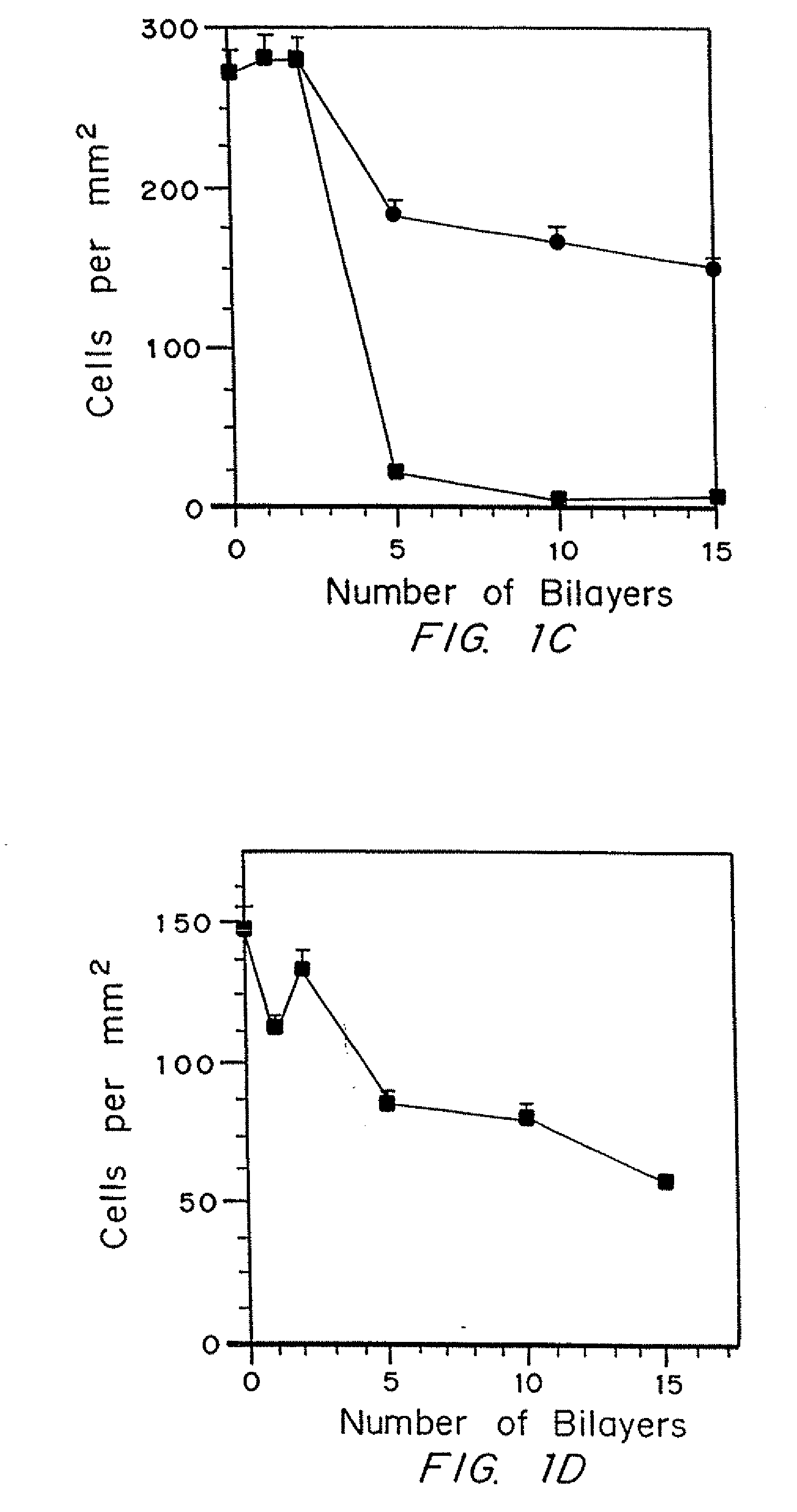Multifunctional polymeric tissue coatings
a polymer and tissue technology, applied in the preparation of sugar derivatives, peptide/protein ingredients, macromolecular non-active ingredients, etc., can solve the problems of capsules not remaining intact long after surgery, exogenous cells are destroyed, etc., to reduce the extent of tumor cell metastasis and prevent postoperative adhesion
- Summary
- Abstract
- Description
- Claims
- Application Information
AI Technical Summary
Benefits of technology
Problems solved by technology
Method used
Image
Examples
example 1
Effect of Materials on Cell Spreading
[0093]A variety of methods can be used to optimize the desired properties. For example, when a PEG-b-PLL brush copolymer is used to protect an injured tissue surface from the adhesion of cells approaching from the fluid phase in contact with that tissue surface, the polymeric material can be optimized by conducting studies using a tissue culture model.
[0094]Fibroblasts can be seeded on a multiwell dish treated with proteins adsorbed from cell culture medium containing 10% serum. Some of the wells can be coated with the copolymers, and others can be left uncoated. Then, the surface can be seeded with fibroblasts in culture medium containing 10% serum and the adhesion and spreading can be monitored.
[0095]A measurement of the fraction of cells adhering (Fa) and fraction of cells spreading (Fs) may be made based on morphological criteria using light microscopy. Such measurements conducted 4 hours following seeding can provide useful measures of adhes...
example 2
Evaluation of PEG / PLL Dendrimers
[0103]Various model surfaces were treated with the PEG / PLL, where the PLL is in the form of dendrimers, then washed with PBS. Fibroblasts were then seeded in serum containing media, and the number of spread cells per square millimeter was counted at four hours. The results are shown in Tables 2 (a-c). The results show that as the number of amine groups is increased to 4 or more, the number of spread cells is significantly decreased.
TABLE 2Cell Spreading on TCPS Coated with PEG / PLL dendrimersDendron Generation(# of Amines)PEG 20KPEO 100KPEG 5K—OH (0) 144 ± 13 83 ± 33150 ± 18Y (1) 125 ± 22 147 ± 21 118 ± 371 (2)137 ± 33 92 ± 39132 + / − 8 2 (4)0 ± 033 ± 7 —3 (8)0 ± 00 ± 0 1 ± 1 4 (16)0 ± 03 ± 3— 5 (32)0 ± 0——
[0104]In Table 2, —OH indicates that the polymer is PEG, with 20K, 100K, and 5K representing the molecular weight of the polymers. Y indicates a zero generation dendrimer, in which one amino group is present.
[0105]The results demonstrate that, at leas...
example 3
Cell Spreading on Polyelectrolyte Multilayers
[0107]HFF Cells on TCPS
[0108]In order to establish a baseline for cell spreading on polyelectrolyte multilayers, multilayers were formed onto tissue culture polystyrene (TCPS) using 0.1% PLL (MW 50,000) and 0.15% alginate, with 4 PBS washes following each adsorption step, out to 15 bilayers. On this surface, the number of well spread cells dropped to zero after the second layer was added (see FIG. 1A). However, quite a few poorly spread cells were observed on the substrates with 2 to 15 layers, with their number remaining somewhat constant out to 15 layers.
[0109]HFF Cells on Gelatin
[0110]Gelatin is produced by denaturing collagen, and substrates for tissue culture are often coated with gelatin to enhance cell attachment to a substrate. As a denatured protein, a mixture of hydrophobic and hydrophilic residues are exposed, and a very heterogeneous surface should be generated upon adsorption to a surface.
[0111]Using 0.1% PLL and 0.15% algina...
PUM
 Login to View More
Login to View More Abstract
Description
Claims
Application Information
 Login to View More
Login to View More - R&D
- Intellectual Property
- Life Sciences
- Materials
- Tech Scout
- Unparalleled Data Quality
- Higher Quality Content
- 60% Fewer Hallucinations
Browse by: Latest US Patents, China's latest patents, Technical Efficacy Thesaurus, Application Domain, Technology Topic, Popular Technical Reports.
© 2025 PatSnap. All rights reserved.Legal|Privacy policy|Modern Slavery Act Transparency Statement|Sitemap|About US| Contact US: help@patsnap.com



